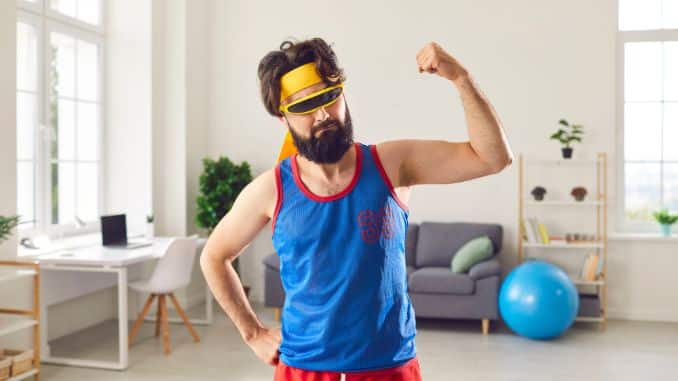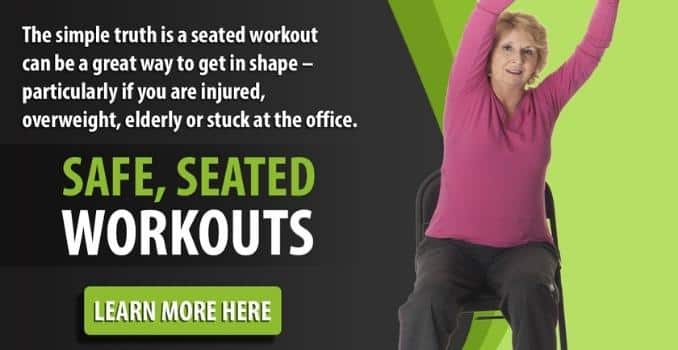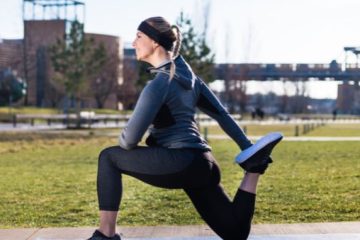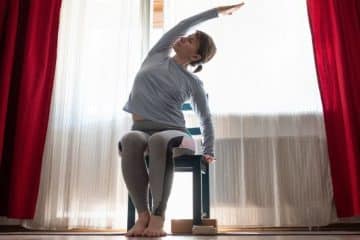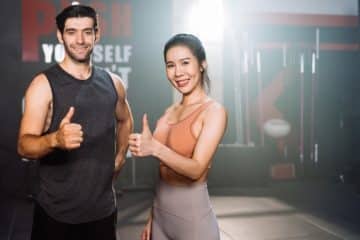Kickstart your upper body strength journey with our super-friendly beginner upper body workout routine! Whether you're a fitness newbie or have some experience, our step-by-step guide covers arms, shoulders, chest, and back exercises to sculpt that upper body. You'll notice improvements from lifting groceries to tackling daily tasks quickly.
Our easy-to-follow instructions ensure you nail each move for maximum results. Strengthening not just muscles but confidence, too! Get ready to feel stronger and accomplished. Dive into your journey for a sculpted upper body—let's make this fitness adventure a breeze together! Ready, set, lift!
Importance Of Upper Body Strength
-
Overall Strength And Muscle Balance
Upper body exercises activate core muscles, promoting overall body strength and stability. Balancing upper and lower body strength is vital to prevent imbalances that can cause injuries. This underscores the importance of core engagement and balanced muscle development across the body for optimal physical stability and well-rounded strength.
-
Metabolism And Weight Management
Strength training, including upper body exercises, burns calories and builds muscle. More muscle increases metabolism, aiding weight management and fat loss. Thus, strength training helps with physical strength and boosts metabolism for weight management and fat loss goals.
-
Bone Health
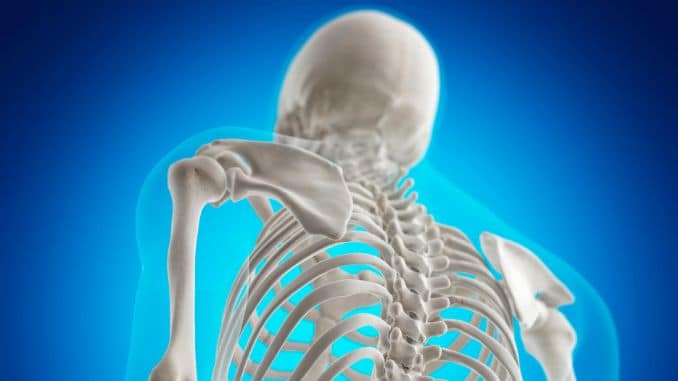
Activities like weightlifting, which enhances upper body strength, improve bone health by increasing bone density. This minimizes the likelihood of osteoporosis and fractures, especially in older individuals. The weight-bearing nature of these exercises strengthens bones, emphasizing the importance of upper-body strength training as a preventive measure for maintaining strong and resilient bones as people age.
-
Psychological Well-being
Building upper body strength has physical benefits, boosts self-confidence, and empowers individuals as they see improvements in their abilities. Furthermore, exercise, including upper body strength training, triggers the release of endorphins, reducing stress and enhancing mood. This highlights how developing upper body strength positively affects mental and emotional well-being.
Understanding The Different Muscle Groups In The Upper Body
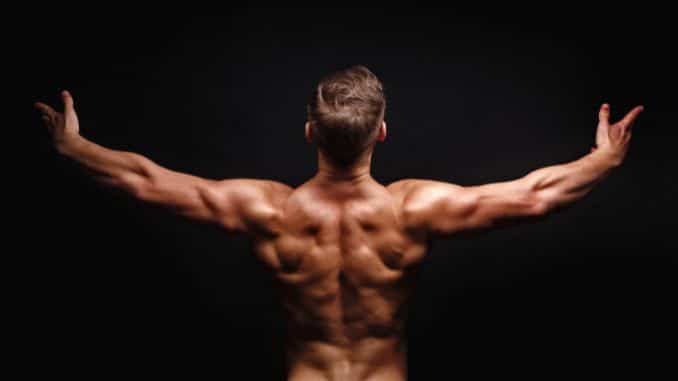
Before diving into the exercises, it's important to understand the different muscle groups in your upper body and how they function.
1. Chest Muscles (Pectorals)
The pectoral muscles, commonly called the pecs, are a prominent muscle group in the chest region. The major and minor pectoralis are vital for various upper body movements. The pectoralis major is responsible for arm flexion, adduction, and internal rotation and is instrumental in exercises like bench presses and push-ups. Strengthening the chest muscles enhances the aesthetic appearance of the chest and contributes significantly to upper body strength and functional capabilities.
2. Shoulder Muscles (Deltoids)
The deltoid muscles are a set of triangular-shaped muscles located on the shoulders. Deltoids facilitate the arm movement's range and consist of the anterior, lateral, and posterior parts. The anterior deltoid is involved in front shoulder raises, the lateral deltoid in lateral raises, and the posterior deltoid in exercises like reverse flies. Developing well-rounded shoulder strength is essential for shoulder stability, injury prevention, and achieving a balanced upper-body physique.
3. Back Muscles
- Latissimus Dorsi (Lats)
The latissimus dorsi, or lats, are the broad muscles spanning the back, resembling wings. These muscles are engaged in movements like pulling and extending the arms. Exercises such as Pull-ups, Lat Pulldowns, and Rows target the lats, contributing to V-shaped back and upper body strength.
- Rhomboids And Trapezius
The rhomboid muscles, situated between the shoulder blades, and the trapezius muscles along the upper spine are crucial for upper back strength and stability. Strengthening these muscles through exercises like rows and shrugs enhances posture and supports the upper back's overall integrity.
4. Arms
- Biceps Brachii
The biceps brachii, also known as the biceps, is found on the anterior side of the upper arms. This muscle, consisting of two heads, plays a role in elbow flexion and forearm supination. Bicep curls, chin-ups, and hammer curls effectively target the biceps.
- Triceps Brachii
The triceps brachii, situated at the rear of the upper arm, play a role in elbow extension. Tricep dips, extensions, and pushdowns effectively target the triceps, contributing to arm strength and definition.
5. Forearm
- Wrist Flexors And Extensors
The forearm house muscles control wrist movements and grip strength. Strengthening these muscles is crucial for activities involving hand-wrist coordination. Wrist curls, reverse wrist curls, and farmer's walks target the wrist flexors and extensors, promoting forearm strength and functionality.
Understanding the intricacies of each upper body muscle group and incorporating targeted exercises into a comprehensive workout routine ensures holistic development, functional strength, and a balanced physique.
Assessing Your Current Fitness Level
Before starting any body workout routine, assessing your current fitness level is important. This will help you tailor the exercises to your needs and ensure you progress safely and effectively.
Consider these important factors when assessing your fitness:
-
Cardiovascular Endurance
Assess how well your heart and lungs perform during sustained physical activity. This can be evaluated through activities like brisk walking, jogging, cycling, or other aerobic exercises. Measure how long you can sustain moderate-intensity exercise and how quickly your heart rate recovers after exertion.
-
Muscular Strength
Evaluate your overall strength by gauging your ability to lift weights or perform bodyweight exercises. Assess specific muscle groups, such as the upper body, lower body, and core. Pay attention to the amount of resistance or weight you can handle for different exercises and how it progresses over time.
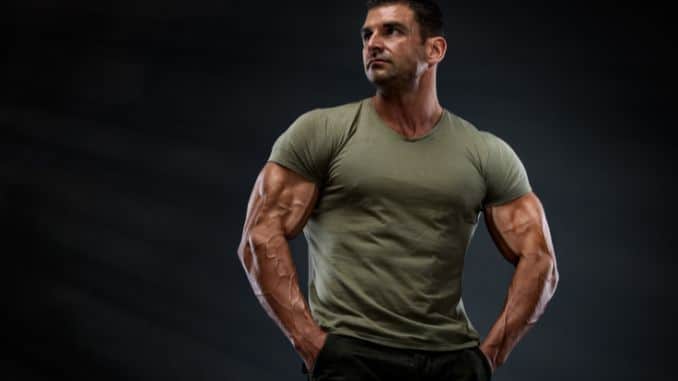
-
Muscular Endurance
Consider how well your muscles endure repeated contractions over an extended period. This can be assessed through activities like push-ups, bench presses, squats, or plank exercises. Note the number of repetitions you can perform with proper form and how your endurance improves with consistent training.
-
Flexibility
Assess your range of motion and flexibility in various joints. Engage in stretching exercises for major muscle groups, focusing on areas like the shoulders, hips, and hamstrings. Evaluate your ability to reach, bend, and move comfortably without restriction.
-
Body Composition
Evaluate your body composition, which includes the distribution of muscle and fat. Measure factors like body weight, body mass index (BMI), and body fat percentage. While these metrics provide a general overview, consider other indicators like waist circumference and changes in muscle mass.
-
Balance And Coordination
Assess your ability to maintain balance and coordination during different activities. Practice standing on one leg, walking straight, or performing exercises that challenge stability. Improved balance contributes to injury prevention and overall functional fitness.
Warm-Up Exercises For Upper Body Strength Training
Before diving into the main workout, it's crucial to warm up your upper body muscles to prevent injuries and improve performance.
1. Shoulder Rolls
Begin this beginner upper body workout in an upright standing position with your feet shoulder-width apart while maintaining good alignment with your head, shoulders, hips, and legs. Engage your core. Lift your shoulders, then roll them down and back until you feel resistance in your shoulder blades. After several movements, lower your shoulders to the starting position and repeat the movement in the opposite direction.
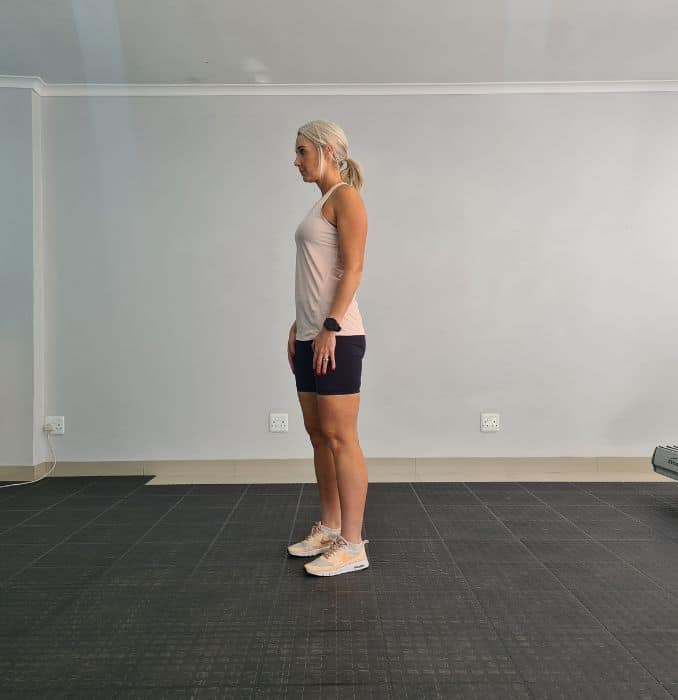 |
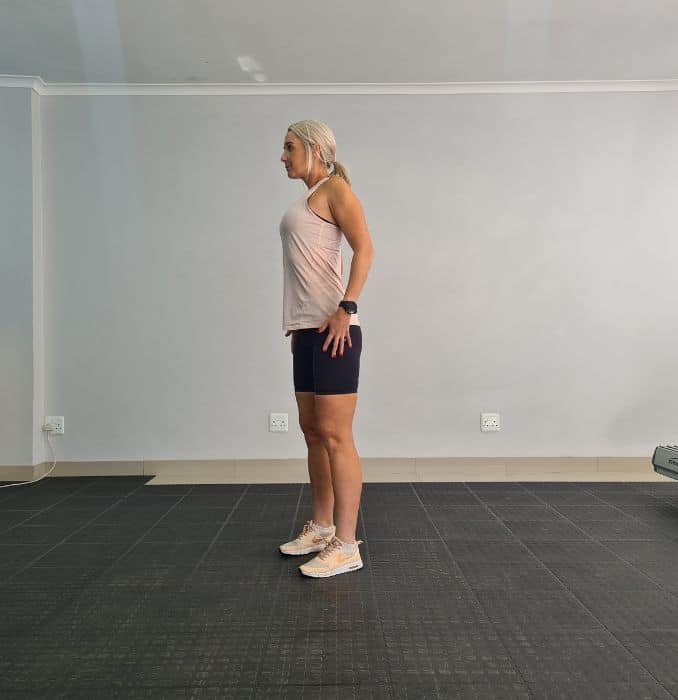 |
2. Arm Raises
Begin in an upright standing position with your legs shoulder-width apart, maintaining good alignment with your head, shoulders, hips, and legs. Place both arms on your side. Engage your core and raise both of your arms straight overhead. Return to the starting position and repeat the movement as needed.
3. I.Y.T
Begin in an upright standing position with your legs shoulder-width apart, maintaining good alignment with your head, shoulders, hips, and legs. Bend through your hips and knees to move into a semi-squat position and extend both arms towards the floor, shoulder-width apart. With your knees bent slightly, engage your core and raise your arms directly overhead, making an ‘I’ shape with your upper body. Lower your arms down to the starting position, then raise your arms overhead at a 45-degree angle, making a ‘Y’ shape with your upper body. Lower your arms to the starting position, then raise them out at your sides to shoulder height, making a ‘T’ shape with your upper body. Repeat the sequence of movements for 10 repetitions.
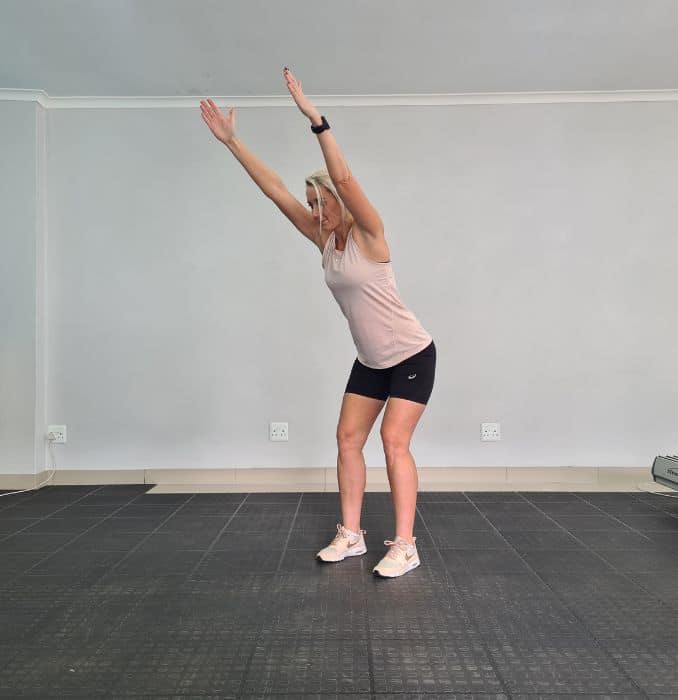 |
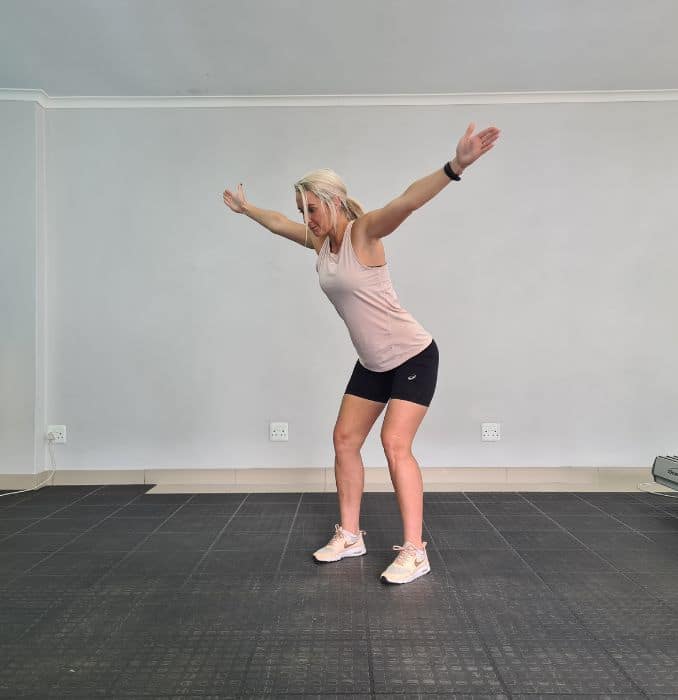 |
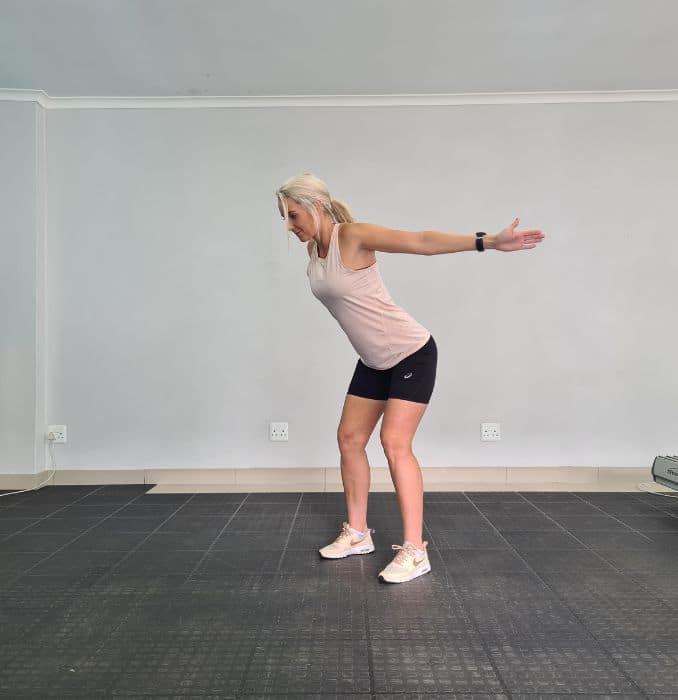 |
Beginner Upper Body Workouts
Now that you're ready let's dive into beginner's upper body training for building upper body strength. This routine consists of exercises that target each major muscle group in your upper body.
1. Bend-Over Rows
For this exercise, you can utilize resistance tubing for added resistance.
Begin this beginner upper body workout in an upright standing position with your feet hip-width apart while maintaining good alignment with your head, shoulders, hips, and legs. Step on the center of the tubing with one foot, holding the tubing handles in each hand. Hinge through your hips to lean your upper body forward. Engage your core and pull your arms back in a rowing motion, keeping your elbows bent at 30 to 45 degrees away from your body. Lower your arms down to the starting position and repeat the movement. Complete 3 sets for 12 repetitions.
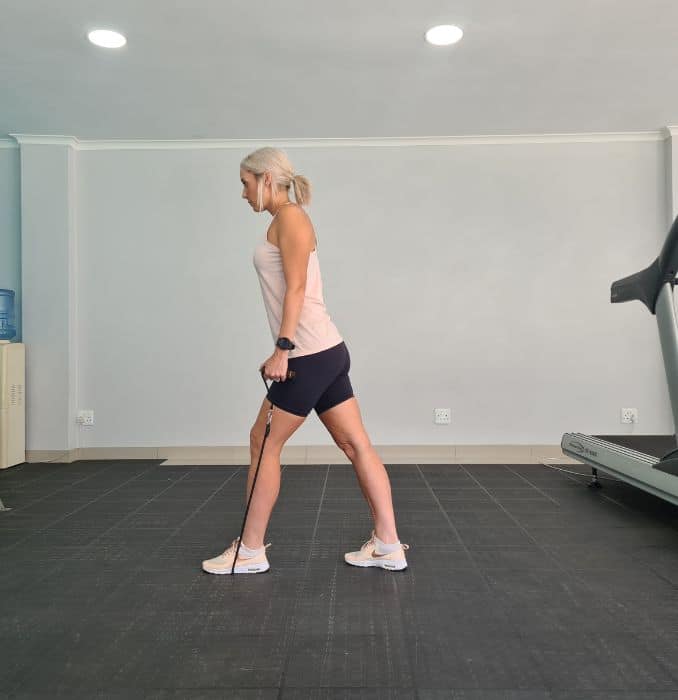 |
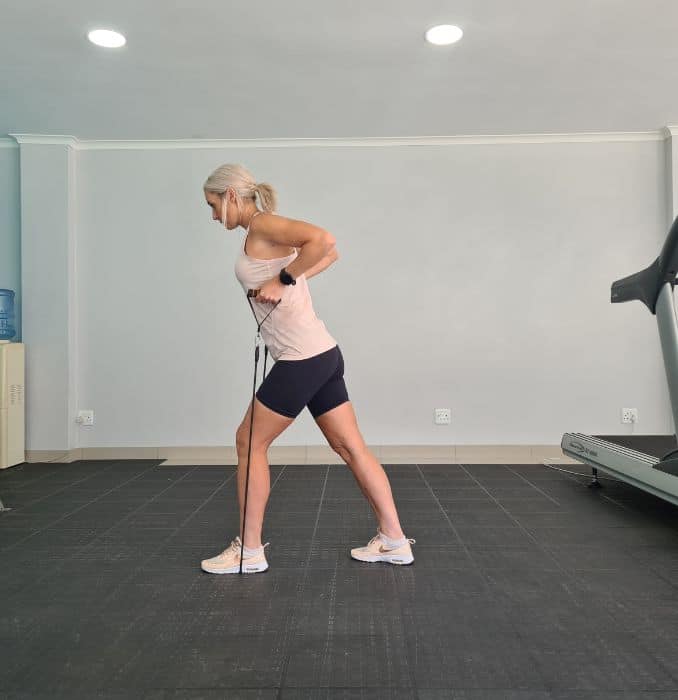 |
2. Reach And Pull
For this exercise, you can utilize a resistance tubing for added resistance.
Begin in an upright standing position with your feet shoulder-width apart, maintaining good alignment with your head, shoulders, and hips. Step one foot forward and slightly bend your front knee. Wrap the resistance tubing around your mid back while holding the tubing handles in each hand. Engage your core and extend both of your arms forward at chest height, creating resistance on the tubing. Pull your arms back, squeezing your shoulder blades together at the end position. Return to the starting position and repeat the movement. Complete 3 sets for 12 repetitions.
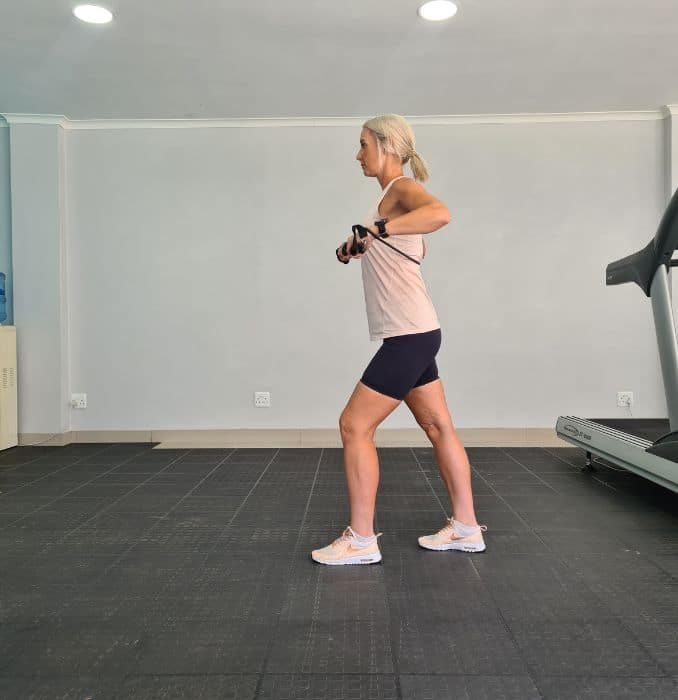 |
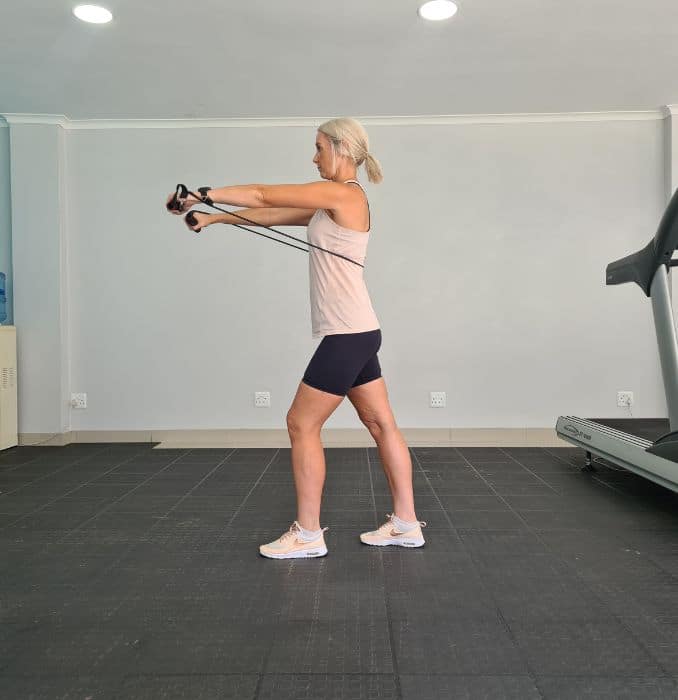 |
3. Overhead Shoulder Press
For this exercise, you can utilize a resistance tubing for added resistance.
Begin in an upright standing position with your feet shoulder-width apart, maintaining good alignment with your head, shoulders, and hips. Step on the center of the resistance tubing with one foot, holding the tubing handles in each hand. Bend your elbows at a 90-degree angle, bringing the tubing handles to shoulder height. Engage your core and extend your arms overhead, creating resistance on the tubing. Hold this position for a few seconds. Lower your arms back to shoulder level and repeat the movement. Complete 3 sets for 12 repetitions.
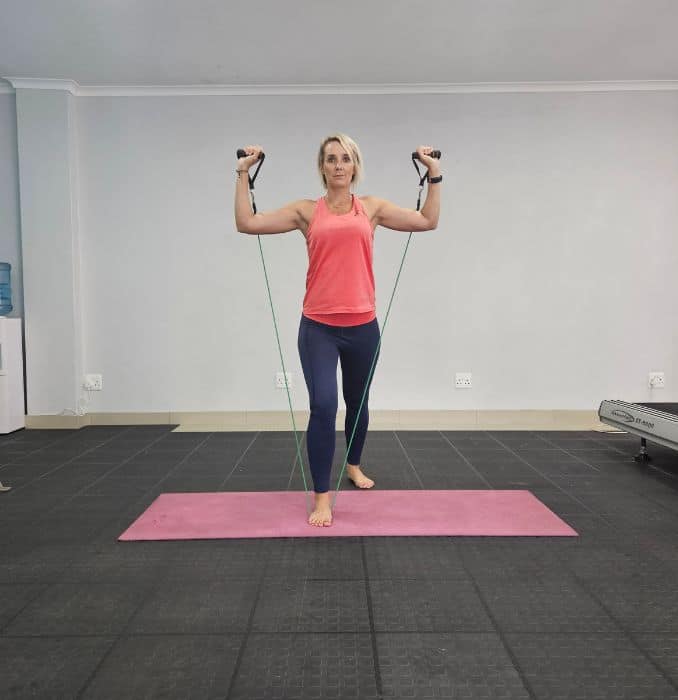 |
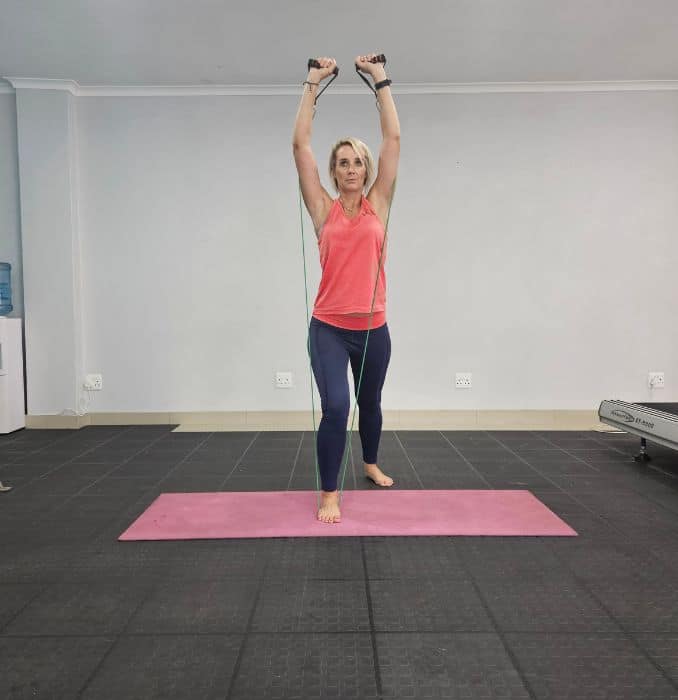 |
4. Shoulder Extension
For this exercise, you can utilize a resistance tubing for added resistance.
Begin this beginner body upper workout in an upright standing position with your feet hip-width apart, while maintaining good alignment with your head, shoulders, hips, and legs. Step on the center of the resistance tubing with one foot, holding the tubing handles in each hand in an overhand grip. Engage your core and raise one arm to shoulder height, creating resistance on the tubing. Lower your arm to return to the starting position and repeat the movement. After several repetitions, perform the movement on the opposite side. Complete 3 sets of 12 repetitions on each side.
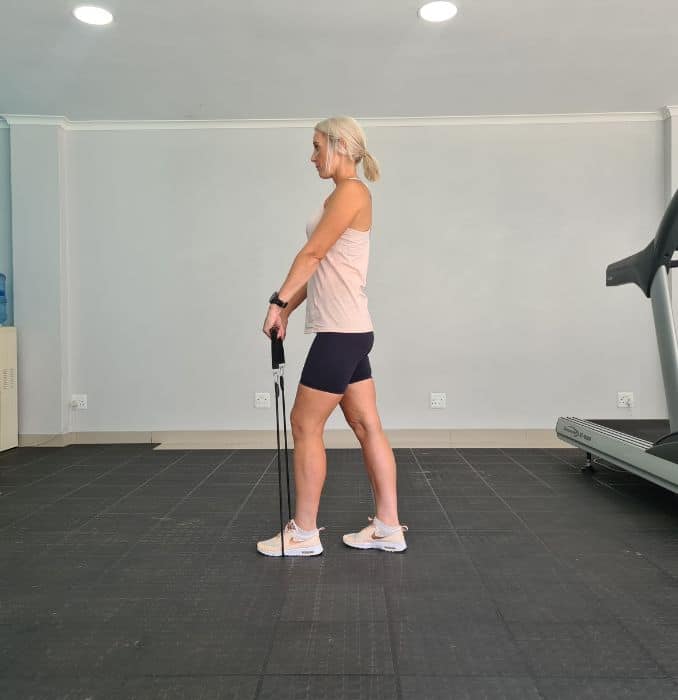 |
 |
5. Bicep Curls
For this exercise, you can utilize a resistance tubing for added resistance.
Begin in an upright standing position with your feet hip-width apart while maintaining good alignment with your head, shoulders, hips, and legs. Step on the center of the resistance tubing with one foot, holding the tubing handles in each hand at hip height with your palms facing upward. Engage your core and curl your arms, bringing the tubing handles to shoulder level. Lower your arms to return to the starting position and repeat the movement. Complete 3 sets for 12 repetitions
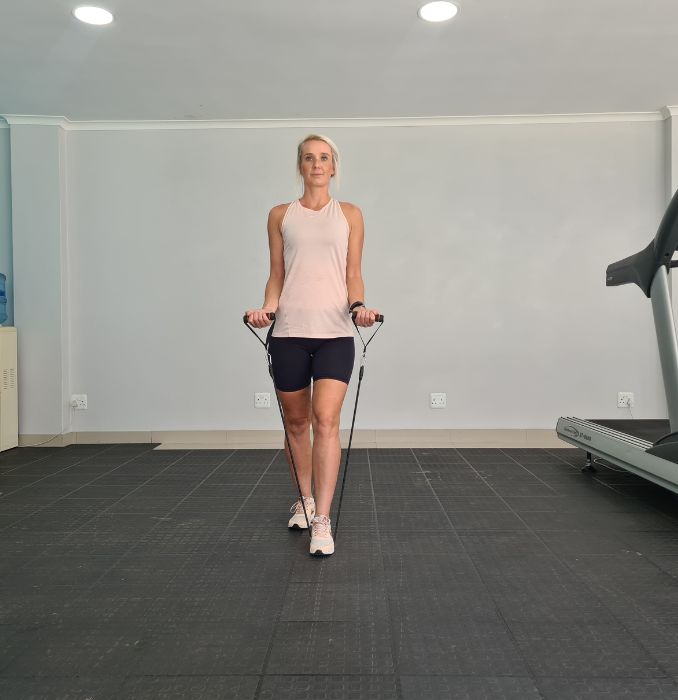 |
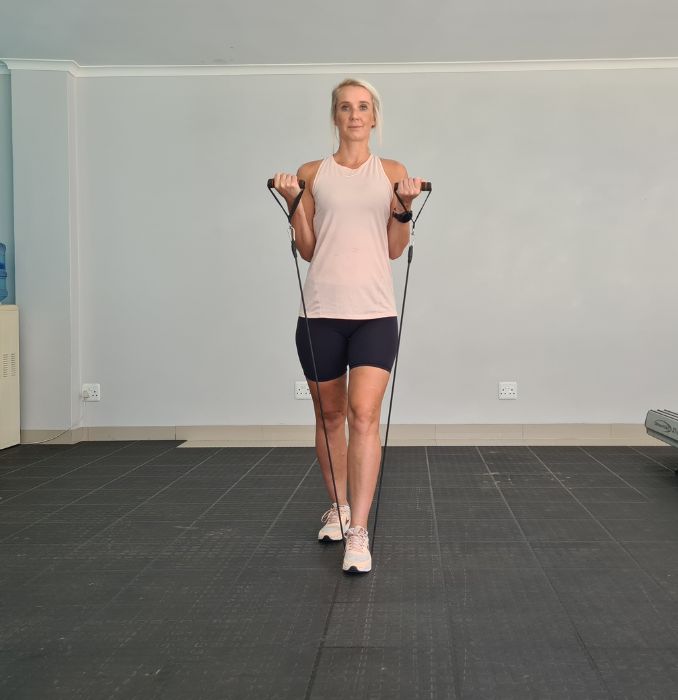 |
6. Tricep Extensions
For this exercise, you can utilize a resistance tubing for added resistance.
Begin in an upright standing position with your feet hip-width apart, maintaining good alignment with your head, shoulders, hips, and legs. Wrap the middle of the resistance tubing around your belly, holding the ends of the tubing in each hand. Step one foot forward and slightly bend your front knee. Engage your core and extend your arms back past your hips, creating resistance on the tubing. Bend your arms to return to the starting position and repeat the movement. Complete 3 sets for 12 repetitions.
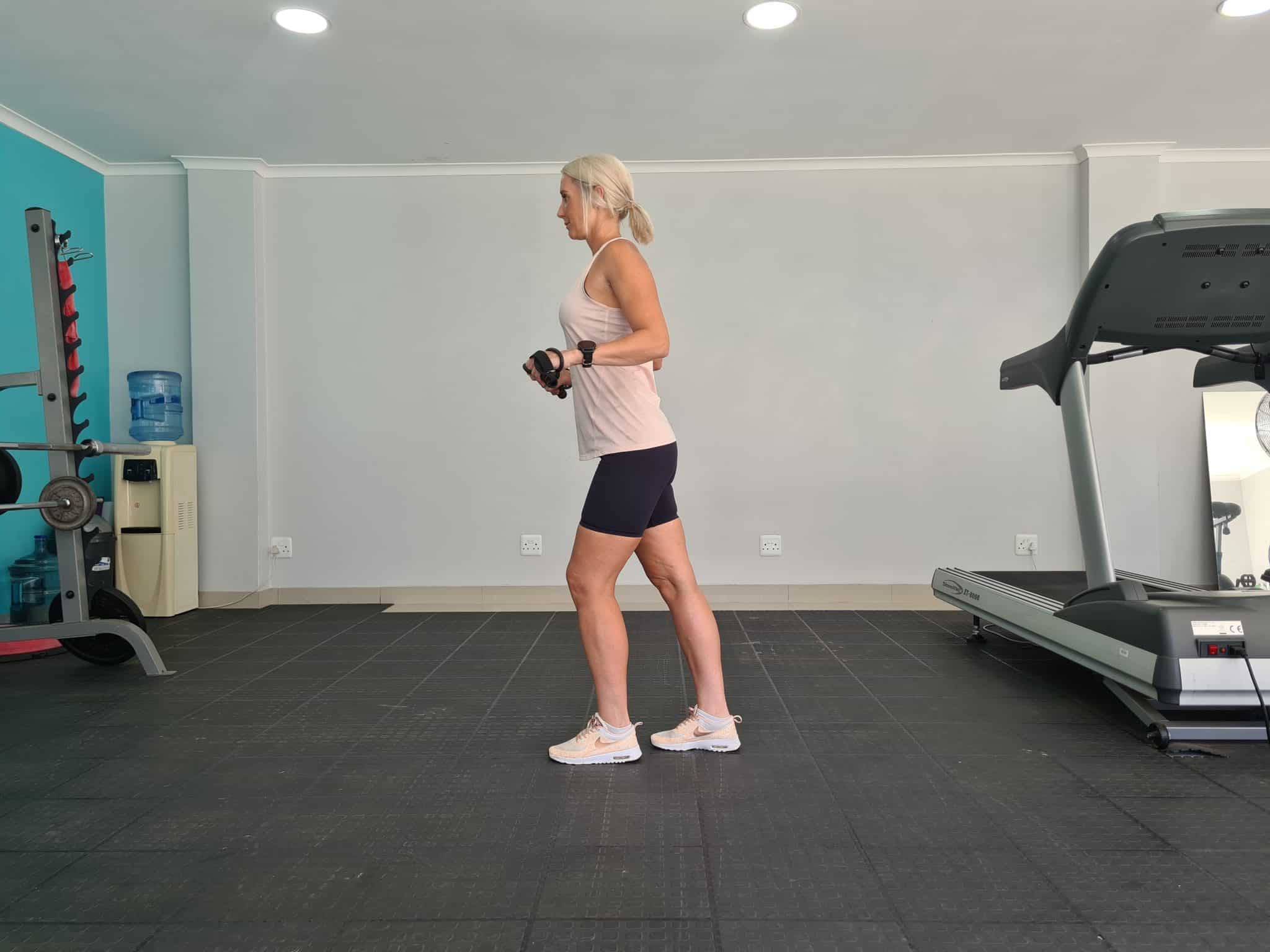 |
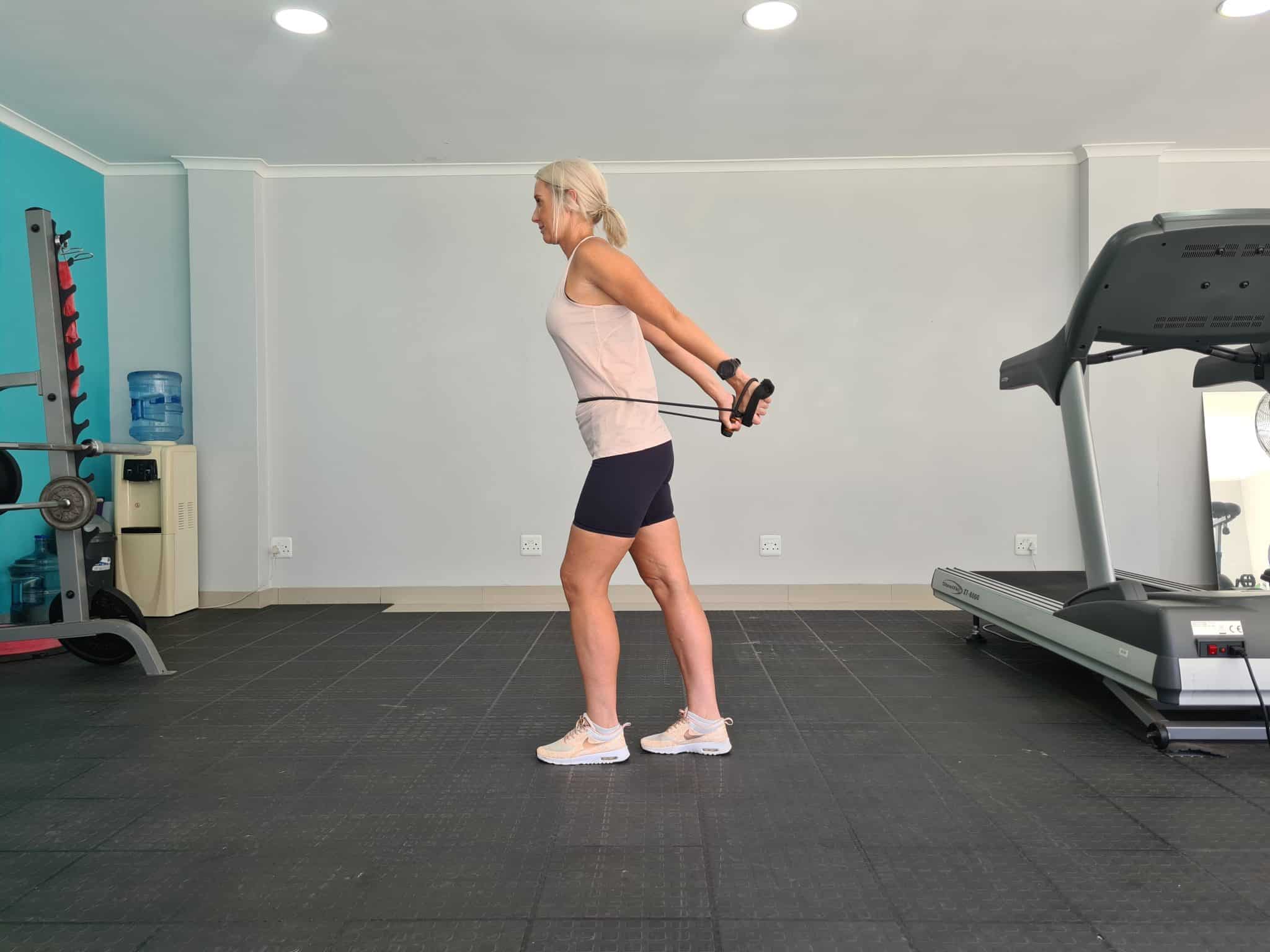 |
Cool-Down Workouts
After vigorous routines, do not forget to perform some cool-down exercises to help relax your muscles.
1. Side Bend
Begin this beginner upper body workout in an upright standing position with your feet hip-width apart, maintaining good alignment with your head, shoulders, hips, and legs. Interlace your fingers with your palms facing outward and extend your arms overhead. Engage your core and bend your upper body to the side, holding this position for a few seconds. Relax and return to the starting position. Repeat the movement on the other side. Perform the movement as needed.
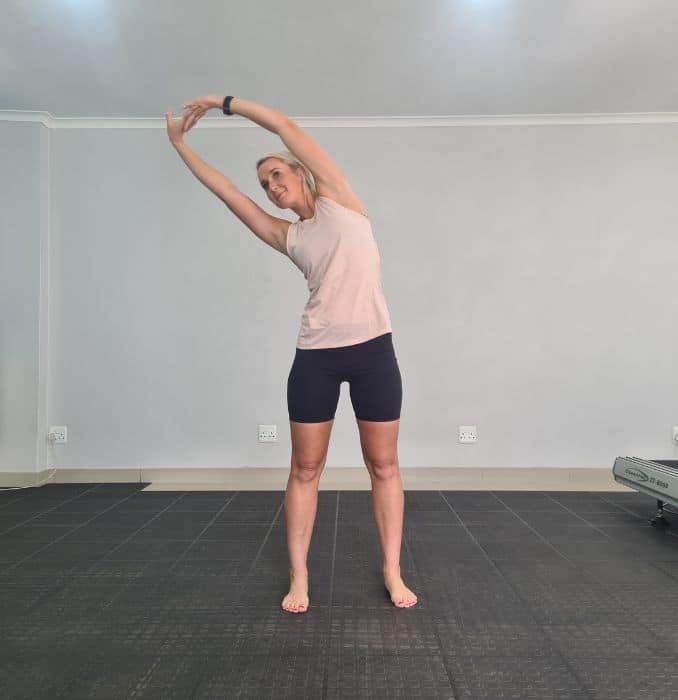 |
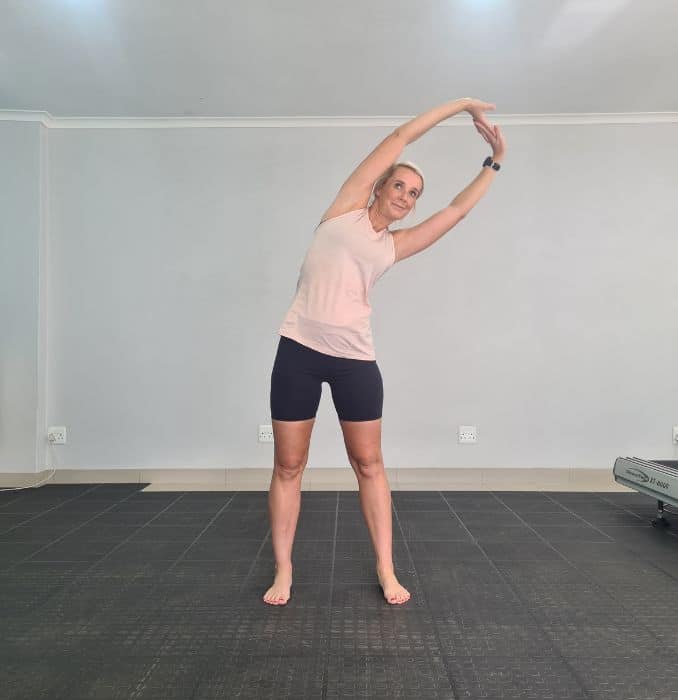 |
2. Back Bend
Begin in an upright standing position with your feet shoulder-width apart, maintaining good alignment with your head, shoulders, hips, and legs. Place your hands on your lower back or upper pelvis area. Engage your core and arch your back, focusing on the stretch happening in your lower back area. Hold this position for several deep belly breaths through your nose and mouth. Relax and return to the starting position. Repeat the movement as needed.
 3. Upper Back Stretch
3. Upper Back Stretch
Begin this beginner upper body workout in an upright standing position with your feet shoulder-width apart, while maintaining good alignment with your head, shoulders, hips, and legs. Extend your arms in front of your body below shoulder height and interlace your fingers. Tighten your core and pull your arms forward as you drop your chin down towards your chest, rounding out your midback. Hold this position for a few seconds. Relax and return to the starting position. Repeat the movement as needed.
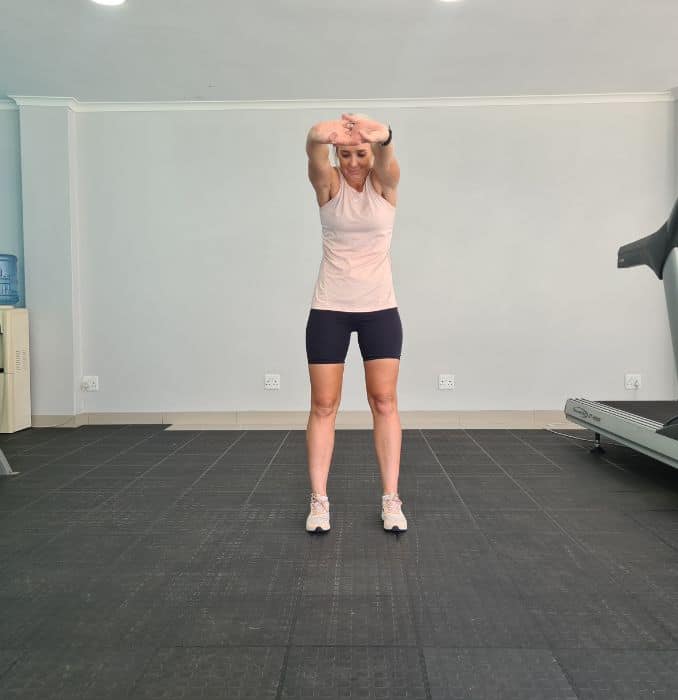
Note: You may add shoulder rolls for a more relaxed feeling.
Conclusion
Commencing building upper body strength as a beginner is like stepping into a transformative adventure. Whether lifting weights or diving into bodyweight exercises, it's not just about the physical gains—it's a holistic experience. Envision improved posture, resilience against injuries, and a surge in confidence as you progress. This isn't just a workout routine; it's a pathway to feeling empowered and stress-free. So, embrace the challenge, enjoy the process, and let the gains be your companions on the road to becoming a stronger, more confident version of yourself!
Enjoy the Amazing Benefits of Exercise with a Safe, but Also Challenging Seated Workout Program – With the Added Benefits of Ankle/Wrist Weights!

